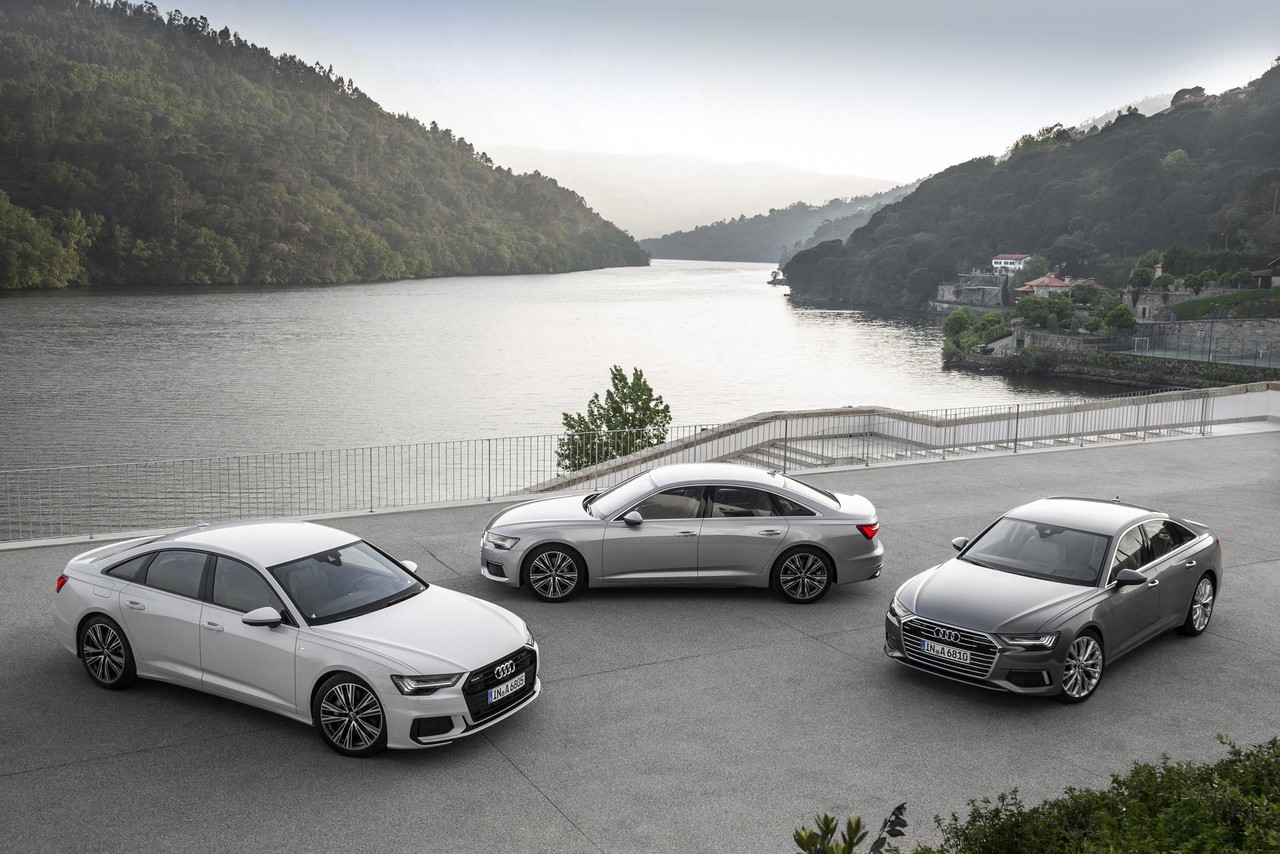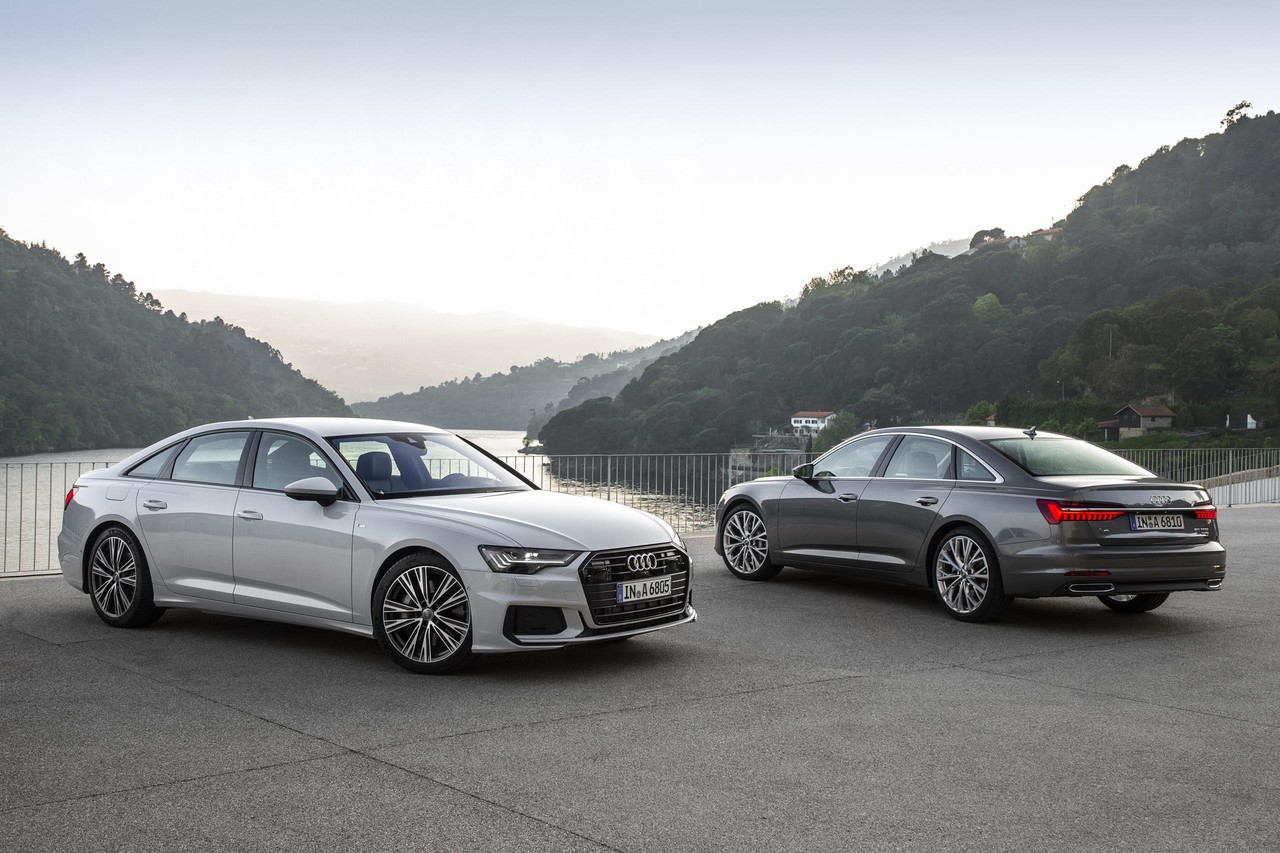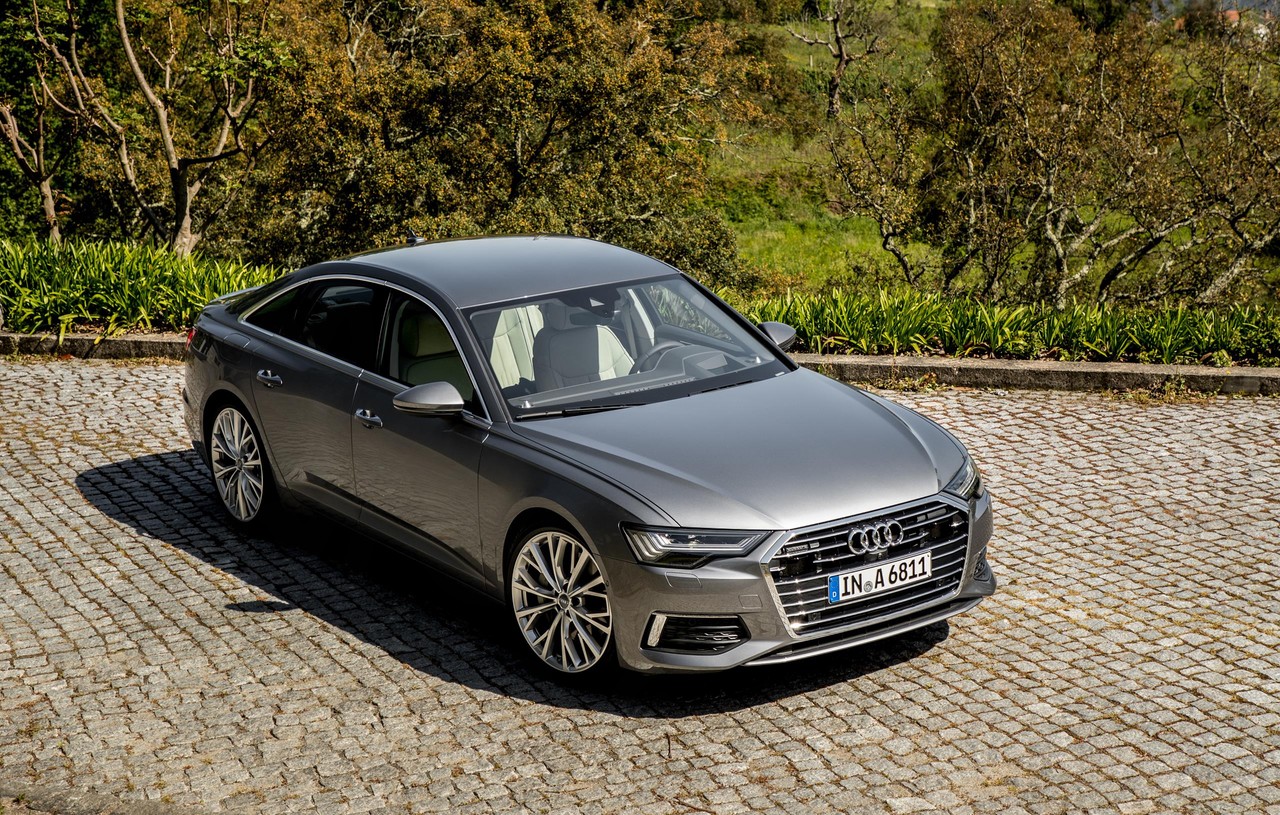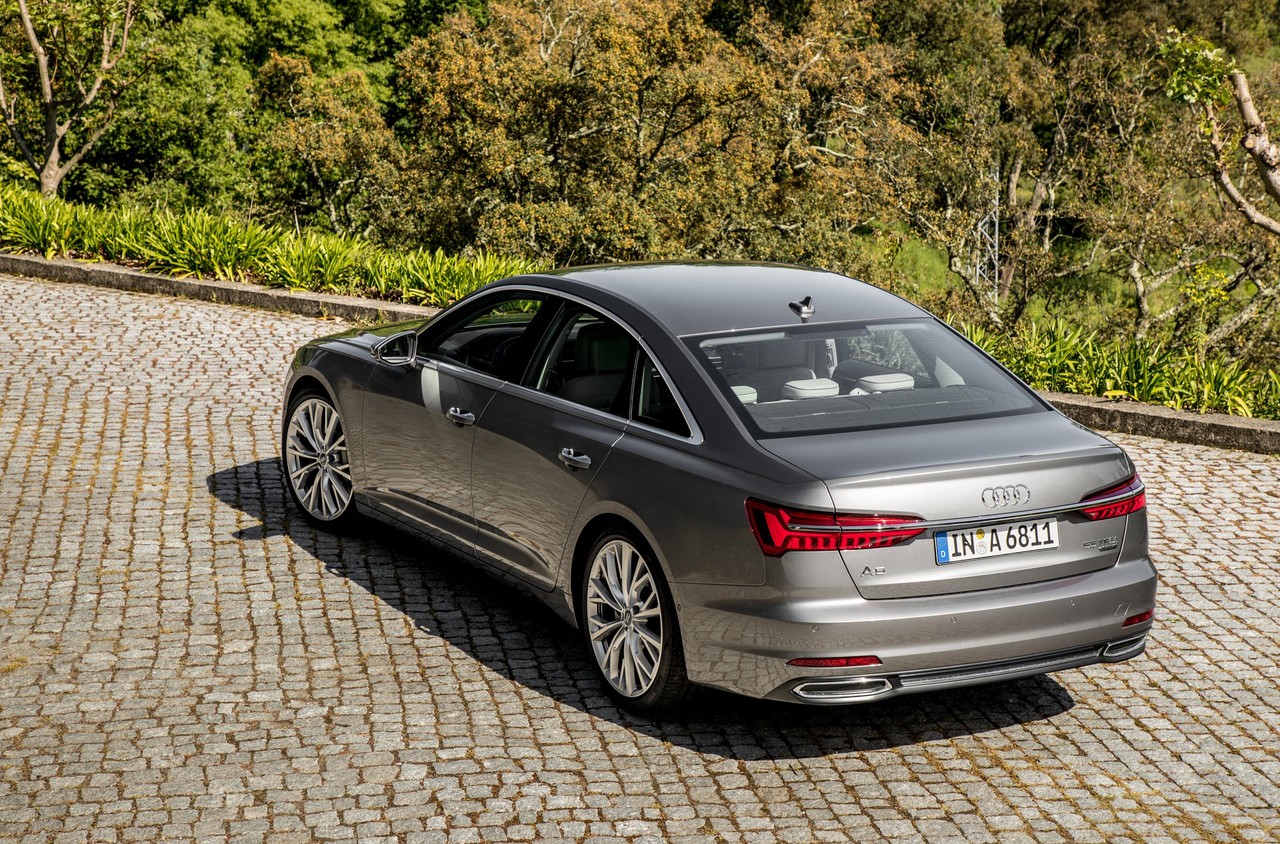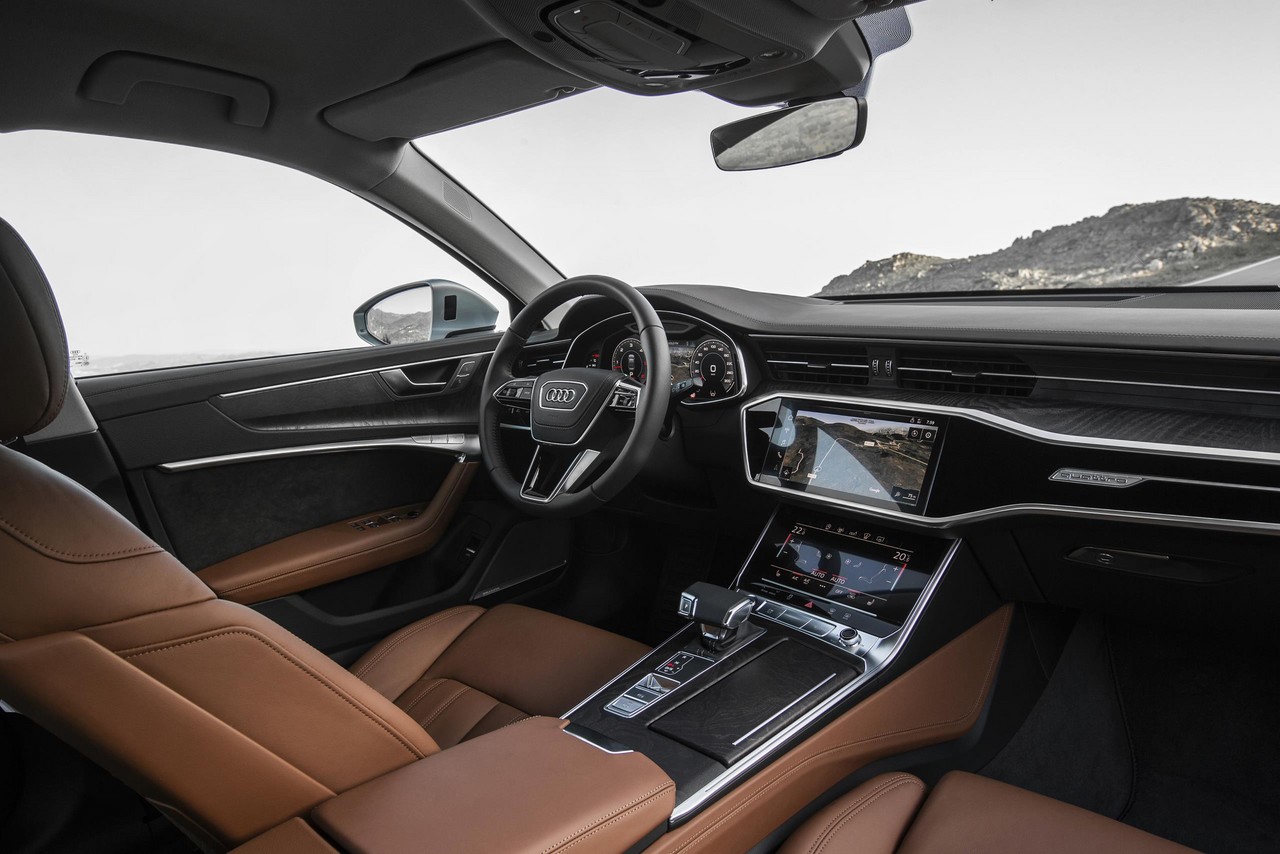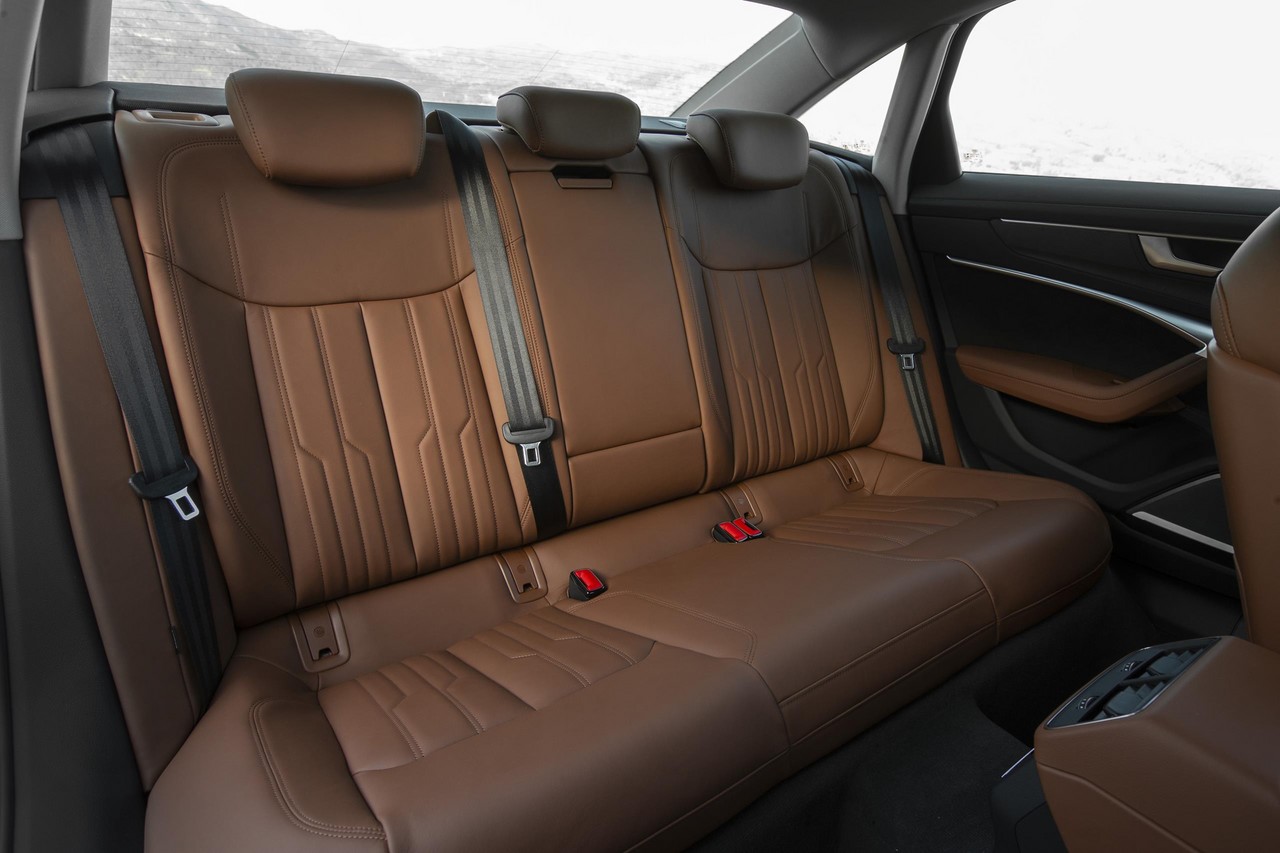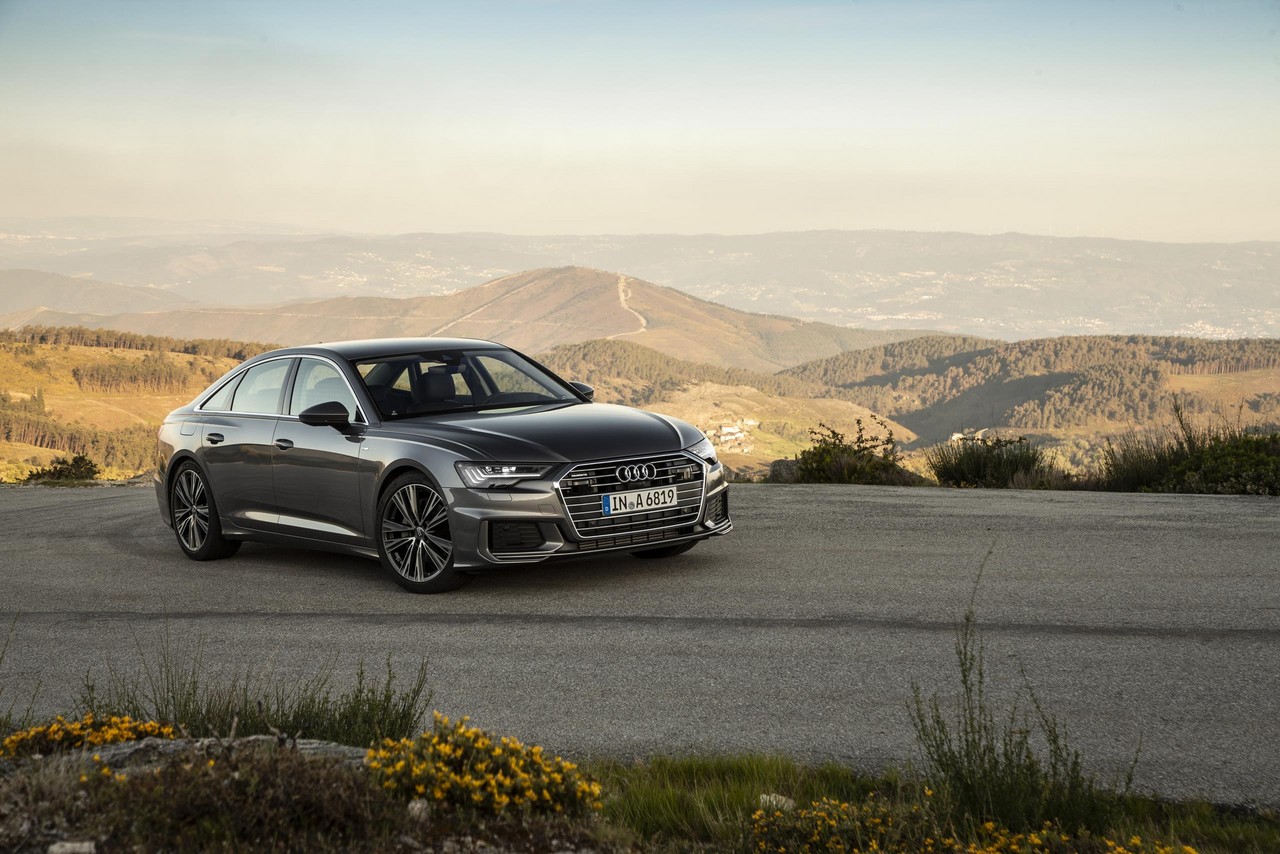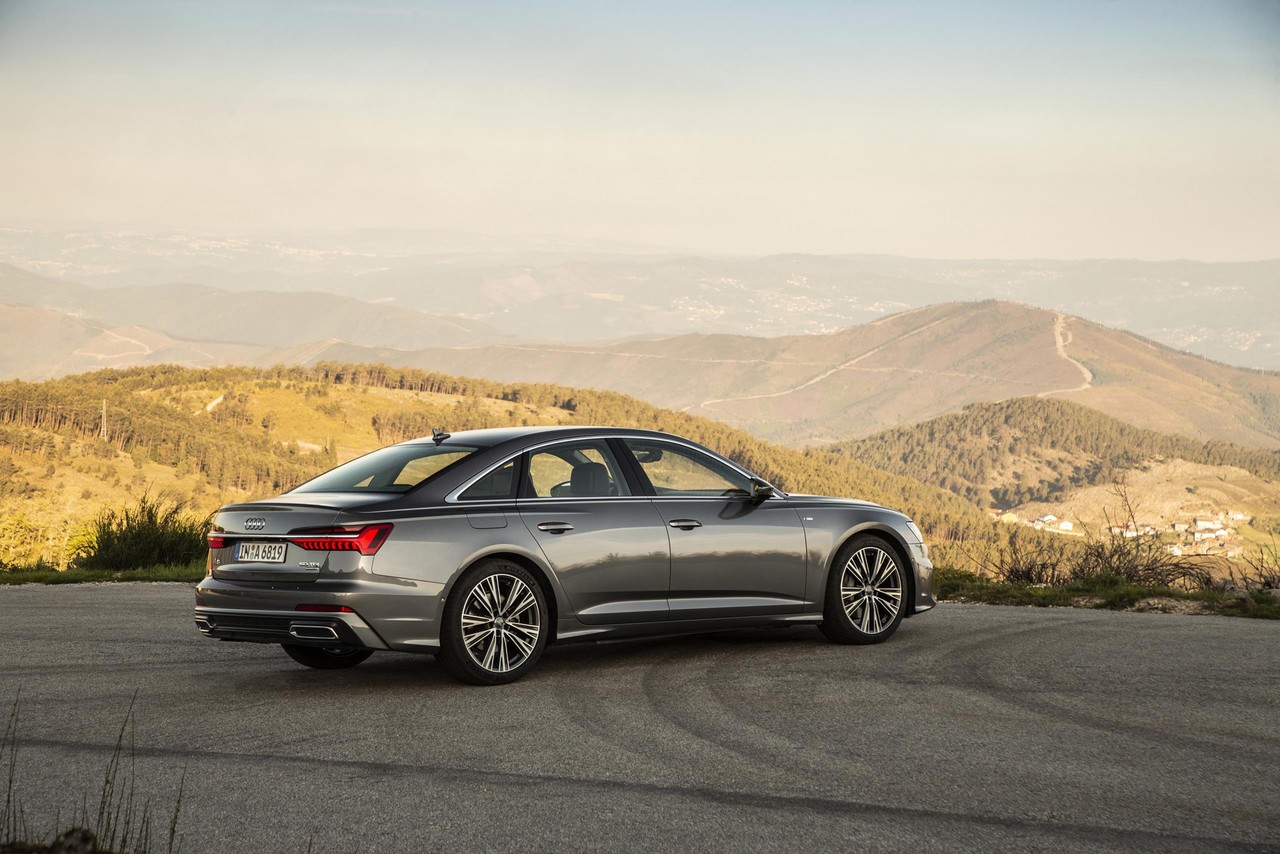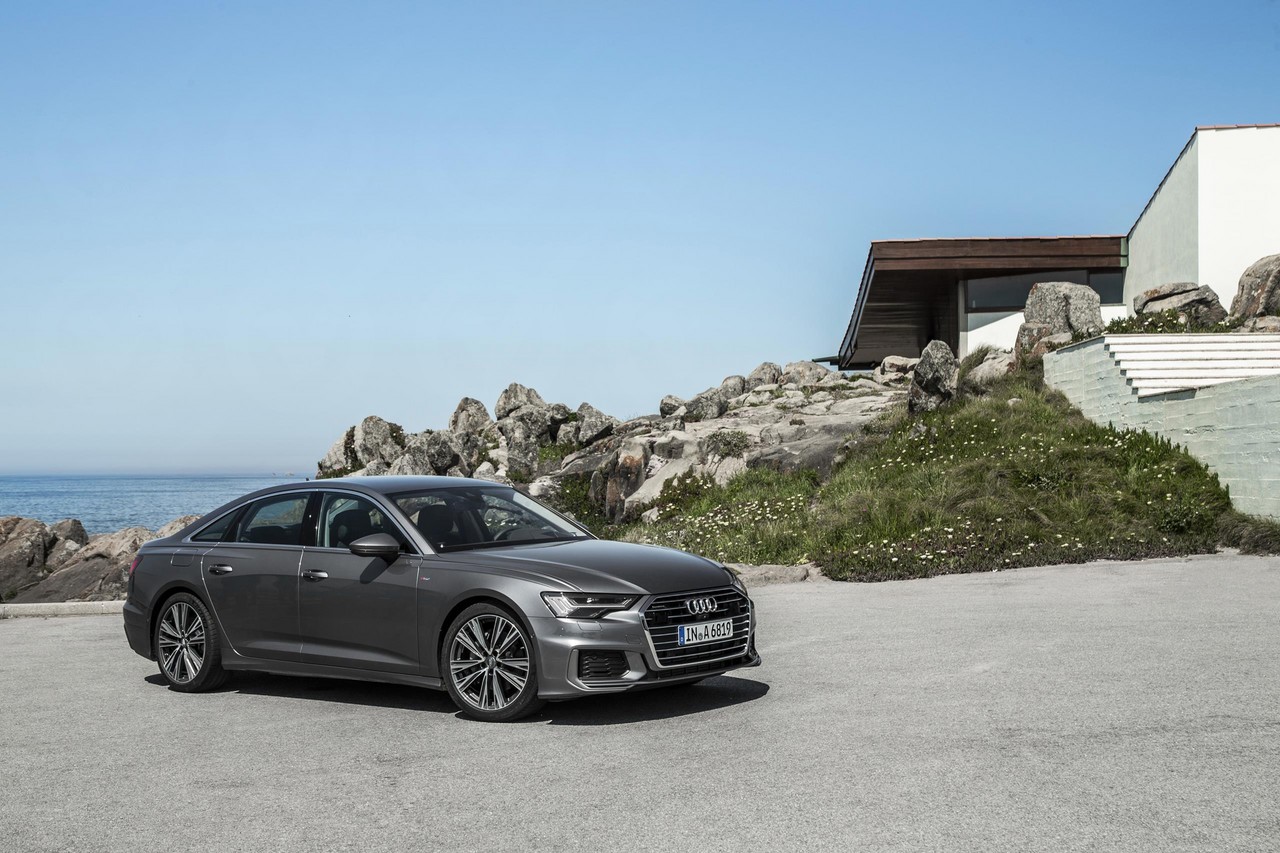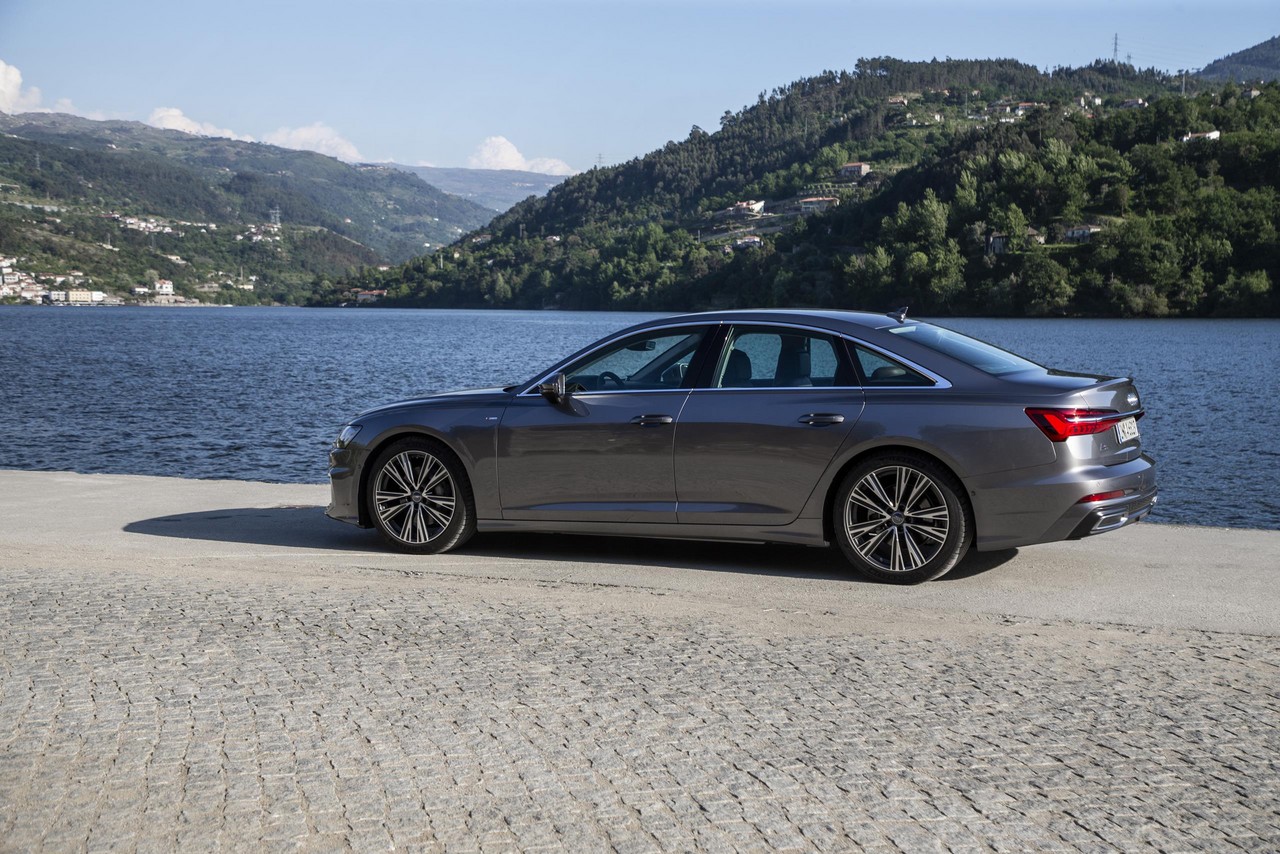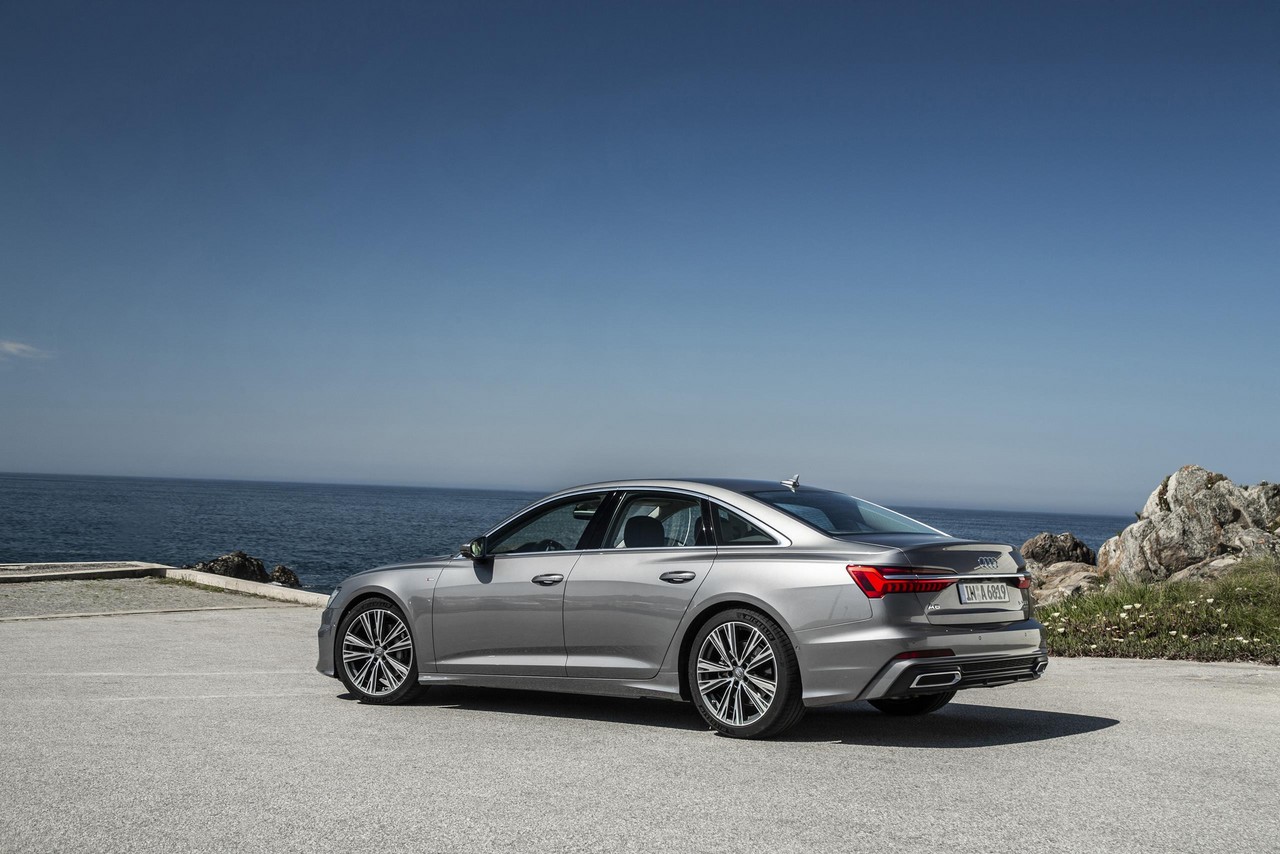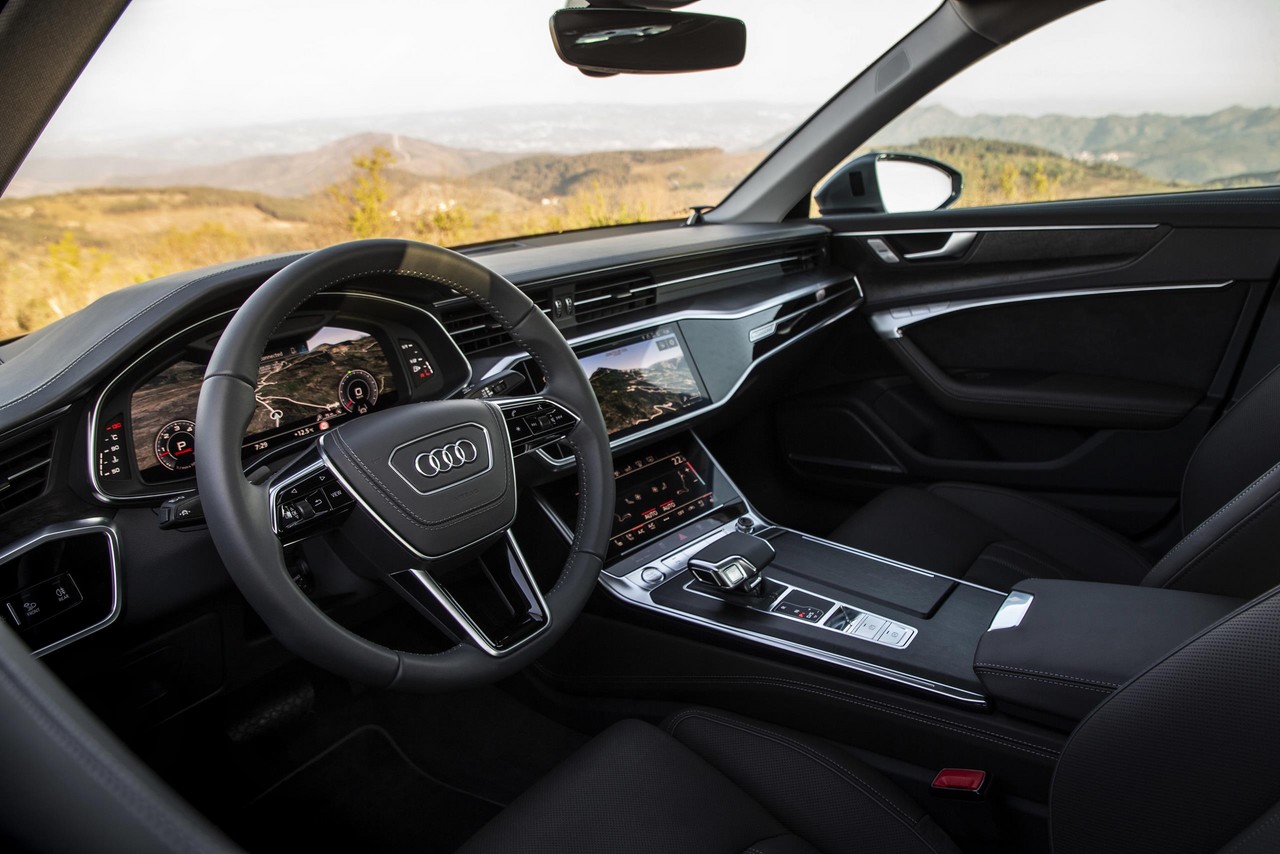
- Standard ‘mild hybrid’ system reduces fuel consumption
- All-wheel drive traction (albeit via permanent and on-demand systems)
- Large boot (530 litres)
- High standard of interior fit and finish
- Are four different types of suspension really necessary? And will the standard steel springs provide a comfortable ride?
- How about making all active safety technologies standard rather than splitting them into ‘City’, ‘Tour’ and ‘Park’ packages?
- Steering feel?
- Raked roofline reduces rear headroom
Overview
Production of the Audi C8 A6 Sedan commenced in June 2018 and it will be released in Australia in August 2019. Manufactured in Neckarsulm, Germany, the Audi C8 A6 range for Australia will consist of the 45 TFSI quattro, 45 TFSI quattro S line and 55 TFSI quattro S line.
For the Audi C8 A6, all engines are equipped with a ‘mild hybrid’ system which consists of a belt alternator starter (BAS) and a 10 Ah lithium-ion battery. As a result,
- The Audi A6 can coast at speeds between 55 km/h and 160 km/h for up to 40 seconds. When the driver resumes acceleration, the BAS starts the engine ‘quickly and smoothly’;
- For models with V6 engines, their 48V main electrical system enables the start-stop function to engage once vehicle speed decrease to 22 km/h;
- When stationary, the engine restarts as soon as the vehicle ahead starts moving; and,
- During deceleration, the BAS can recover up to 12 kW of power which it stores in the lithium-ion battery.
According to Audi, mild hybrid technology reduces fuel consumption in real-world driving by up to 0.7 litres per 100 kilometres.
| Variant | Engine | Trans. | Peak power | Peak torque |
|---|---|---|---|---|
| 45 TFSI quattro | 1984 cc turbo petrol I4 | 7sp DCT | 180 kW at 5000-6500 rpm | 370 Nm at 1600-4300 rpm |
| 55 TFSI quattro | 2995 cc DLZA turbo petrol V6 | 7sp DCT | 250 kW at 5000-6400 rpm | 500 Nm at 1370-4500 rpm |
‘quattro’ all-wheel drive systems
quattro (for tiptronic models)
For Audi C8 A6 models with automatic transmissions (Audi’s ‘tiptronic’), the mechanical all-wheel drive system utilises a self-locking central differential (designed as a planetary gear train) which provides permanent all-wheel drive. In normal conditions, the differential provides 60 per cent of the engine’s torque to the rear axle and 40 per cent to the front, i.e. a 40:60 front:rear torque split. Depending on the situation, however, up to 70 per cent of the engine’s torque can be transferred to the front and up to 85 per cent to the rear.
For Audi A6 45 TDI and 50 TDI models with the ‘tiptronic’ automatic transmission, the optional sport differential actively distributes power between the rear wheels, sending more torque to the outer rear wheel when cornering to generate yaw and thereby reduce understeer.
quattro with ultra (for S tronic models)
For C8 A6 models with Audi’s ‘S tronic’ double clutch transmission (i.e. the 40 TDI quattro and 55 TFSI quattro), the Haldex V on-demand all-wheel drive system utilises an electronically-controlled multi-plate clutch. In normal conditions, the engine’s torque is solely directed to the front wheels for fuel efficiency. In the event that the front wheels lose traction or such a loss of traction is anticipated, the multi-plate clutch is activated to direct up to 50 per cent of the engine’s torque to the rear wheels (i.e. a 50:50 front:rear torque split).
‘With a sporty driving style’, the wheel-selective torque control of the sport differential applies light braking to the inner-side wheels when cornering to prevent wheel slip, generate yaw and reduce understeer.
Body and dimensions
The body of the Audi C8 A6 uses hot-formed steel components for key elements of its structure such as the lower section of the front bulkhead, chassis rails, rear cross member, B-pillars and the A-pillars. Beyond this,
- Cast aluminium is used for the front suspension towers;
- Aluminium sheeting is used for the parcel shelf, C-pillar supports, the doors, bonnet, front wings and boot lid; and,
- Aluminium sections are used for the bumpers and suspension strut bars.
In large areas of the body shell, the Audi C8 A6 has sheet metal blanks for which wall thicknesses vary between 0.75 and 2.05 mm
Compared to the Audi C7 A6 sedan , the C8 A6 sedan is 7 mm longer (at 4939 mm), 12 mm wider (1886 mm), 2 mm lower (1457 mm) and a 12 mm longer wheelbase (2924 mm); boot capacity is 530 litres. The Audi A6 has drag co-efficients of 0.24 Cd, 0.26 Cd and 0.27 Cd for the 40 TDI, 50 TDI quattro and 55 TFSI quattro variants, respectively.
Suspension
The Audi C8 A6 has five-link front suspension which is rigidly mounted on a sub-frame and a five-link rear axle which is hydraulically mounted on a sub-frame. Furthermore, the Audi C8 A6 is available with four different forms of suspension:
- Conventional steel spring suspension;
- ‘Sport’ (steel spring) suspension which lowers the body by 20 mm;
- Steel spring suspension with electronically controlled dampers – that only draw power if the valves are closed to increase damper resistance – with ‘comfortable tuning’ and which lower the body by 10 mm; and,
- Adaptive air suspension with controlled damping which enable the driver to select from several modes and adjust ride height. For the air suspension, the bellows of the air springs are made from natural rubber and the compressed air spaces contain ‘carbon air’, i.e. an ‘activated’ carbon elements that act as an adsorptive material (described further below). The body is 20 mm lower than the standard suspension in the ‘normal’ position and, at speeds above 120 km/h, the body is lowered by a further 10 mm to lower the vehicle’s centre of gravity and reduce aerodynamic drag.
Carbon air suspension
Activated carbon is produced by baking organic materials then driving water vapour through the material at high temperature and pressure to excavate the cell cavities. This process produces a carbon skeleton with microscopic pores that serve as transport channels to nanoscopic pores. Through surface chemistry and Van der Waals forces, the use of activated carbon elements in the compressed air spaces of the springs contain more air than standard air springs without contributing to pressure, thereby achieving softer damping.
The ‘carbon air’ springs for the Audi C8 A6 are supplied by Vibracoustic which has licensed the technology from Carbon Air Ltd . The technology for ‘carbon air’ was originally developed at the University of Salford and then commercialised by Carbon Air Ltd. Further information about carbon air suspension is available from the patents held by Vibracoustic and Carbon Air .
Steering
The Audi C8 A6 has rack-and-pinion steering with speed-sensitive, electric power assistance and a progressive steering ratio (i.e. becomes more direct as steering angle increases). The Audi C8 A6 uses strain wave gearing to provide a variable steering ratio; depending on vehicle speed, the steering ratio varies between 9.5:1 and 16.5:1.
As an extra-cost option, the Audi A6 is available with ‘dynamic all-wheel steering’ whereby a spindle drive can turn the rear wheels by as much as five (5) degrees. At speeds below 60 km/h, the wheels steer in the opposite direction to improve manoeuvrability and reduce the Audi A6’s turning circle by up to 1 metre (to 11.1 metres). At speeds above 60 km/h, the wheels turn in the same direction for greater stability.
Safety equipment
Standard safety equipment for the Audi C8 A6 is expected to include dual front airbags, front and rear seat-mounted airbags, full-length curtain airbags (i.e. for front and rear occupants), ABS, electronic brake force distribution, brake assist, electronic stability control, traction control and front seatbelts with pre-tensioners and load limiters.
For its active safety technologies, the Audi C8 A6 has twenty-four (24) scanners:
- A laser scanner mounted in the front bumper. The laser scanner emits light pulses on several vertical planes which are distributed by a mirror over a field about 80 metres deep and through a range of 145 degrees. Since the wavelengths of the pulses are in the near infra-red range, they are not visible to the human eye. The pulses are reflected by objects in front of the car detected by photodiodes in the laser scanner and interpreted for a contoured image of the surroundings;
- A long-range front radar sensor;
- Four mid-range radar sensors at the corners of the vehicle;
- A front infra-red camera;
- A front camera at the top of the windscreen;
- Four cameras at the front, rear and door mirrors for 360 degree coverage; and,
- Twelve ultrasonic sensors at the front, flanks and rear.
All sensor data is processed by the central driver assistance controller (zFAS) to continuously compute a differentiated image of the surroundings. The zFAS controller is approximately the size of a tablet computer and integrates high-performance computers from NVIDIA (Tegra K1), ALTERA (Cyclon V), Infineon (Aurix) and the EyeQ3 image processor from Mobileye.
Active safety technologies for the Audi C8 A6 include –
- Adaptive Cruise Assist (ACA): builds on Adaptive Cruise Control (ACC) by adding a lane tracking function. ACA operates at speeds from rest to 250 km/h to keep the vehicle at the desired distance from the vehicle ahead and uses ‘slight steering interventions’ to help the driver stay in their lane. ACA can be supplemented by ‘predictive control’ and ‘efficiency assist’ to enable an anticipatory driving style. To detect the traffic situation and course of the route, camera images and navigation are combined. If ACC is deactivated, ‘efficiency assist’ indicates to the driver when they should ease off the accelerator;
- Traffic jam assistant: as part of the ACC, the Traffic jam assistant provides automated steering if traffic is congested at speeds below 65 km/h;
- Bottleneck assist: makes steering corrections where roadworks are being carried out if the car gets too close to the edge of the road;
- Pre sense front: operates at speeds up to 250 km/h and can prevent front-to-rear collisions or reduce their severity. In hazardous situations, the driver receives visual and acoustic warnings to apply the brakes, followed by a brief application of the brakes for a jolting effect to alert the driver. If the driver fails to respond, the A6 decelerates to the greatest possible extent if the vehicle ahead of it is still moving;
- Audi pre sense rear: can warn of potential collisions from behind, alert following traffic by rapidly flashing the brake lights and activate the ‘pre sense basic’ protection measures described below;
- Pre sense basic: initiates occupant protection measures such as tightening the front seatbelts, closing the windows and sunroof (where fitted), and activating the hazard lights if ‘unstable driving conditions’ are detected or a collision is anticipated;
- Audi side assist: operating at speeds above 15 km/h, Audi side assist uses two rear radar sensors to monitor traffic up to 70 metres behind the vehicle. If another vehicle approaches quickly or is in the driver’s blind spot, a warning LED in the housing of the appropriate door mirror illuminates. If the driver activates the indicator to change lanes, LEDs blink rapidly to warn the driver;
- Crossing assist: if the mid-range radars detect critical crossing traffic in front of the car, the system warns the driver and applies the brakes if required;
- Turn assist: monitors the lane of oncoming traffic when the driver is turning across it and when oncoming vehicles are turning in front of the vehicle. Turn assist includes individual wheel braking and steering assistance functions;
- Swerve Assist: operating at speeds between 30 km/h and 150 km/h when the driver is taking evasive action. In such situations, swerve assist applies small amounts of steering torque to adjust steering angle so that the vehicle avoids detected obstacles;
- Exit warning: activated when the vehicle is stationary, exit warning warns occupants if vehicles are approaching from behind by illuminating red fibre optics in the door-opening mechanism as the doors were opened;
- Crossing assist front: if the mid-range radars at the vehicle’s corners – which have a range of approximately 75 metres – detect crossing traffic in front of the vehicle, the driver is warned. Furthermore, the brakes are applied if there is a collision risk;
- Cross traffic assist rear: when reversing at low speeds, rear cross-traffic assist uses the rear radar sensors to detect approaching traffic. If approaching traffic is detected which may cross the vehicle’s path, the driver receives warnings (visual, acoustic and a brief, jolting application of the brakes);
- Camera-based traffic sign recognition: uses the camera to identify traffic signs and displays their contents to the driver as graphics in the head-up display and instrument cluster. The driver can also opt to receive visual warnings when they exceed the speed limit indicated on traffic signs; and,
- Emergency assist: brings the vehicle to rest if the driver is not able to do so.
Euro NCAP testing
In Euro NCAP testing , the Audi A6 received a five star safety rating which included a 93 per cent adult occupant protection rating and an 85 per cent child occupant protection rating. Occupant protection in the frontal offset test was generally rated as good, though protection of the lower left leg of both front occupants was rated as adequate (i.e. a slight risk of serious injury), as was chest protection for the driver. While maximum points were awarded in the side impact test, chest protection for the driver in the pole test was rated as marginal (a moderate risk of serious injury).
Features: Audi C8 A6
Where Audi’s ‘MMI navigation plus’ is specified, the Audi C8 A6 has a 10.1-inch central touchscreen and a lower 8.6-inch display for climate control and convenience functions. MMI navigation plus also includes the Audi virtual cockpit with a 12.3-inch display (1920 x 720 pixels). Audi’s ‘Navigation and Infotainment’ services are provided by the Audi connect SIM which is permanently installed in the vehicle and those services are provided free of charge for the first three years after purchase. These services include the Wi-Fi hotspot, which also supports the 5 GHz band, and live traffic information.
Further information regarding standard features will be available closer to launch.
Options: Audi C8 A6
Optional features for the Audi C8 A6 include:
- A&& Olufsen Sound System with 3D sound in the front;
- A Bang & Olufsen Advanced Sound System with 3D sound front and rear, 19 speakers and a total output of 1820 watts;
- Ventilated front seats with massage function;
- Air quality package with fragrances, an ioniser and pollutant filter;
- HD Matrix LED headlights with multi-row high beam which consist of 32 individual light segments and also feature a dynamically controllable dipped beam;
- A head-up display can project information onto the windscreen in a 22 x 8 centimetre area that appears to hover more than two meters in front of the windscreen;
- A panoramic glass sunroof; and,
- The ‘Audi connect key’ which enables an Android smartphone to unlock, lock the car and start the engine using Near Field Communication (NFC). Furthermore, the owner can pass the access data to five smartphones.
